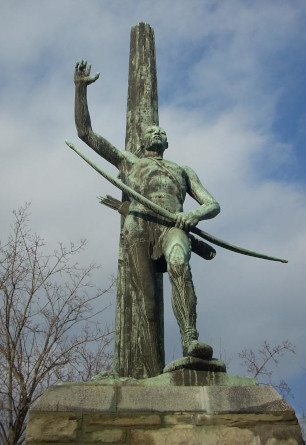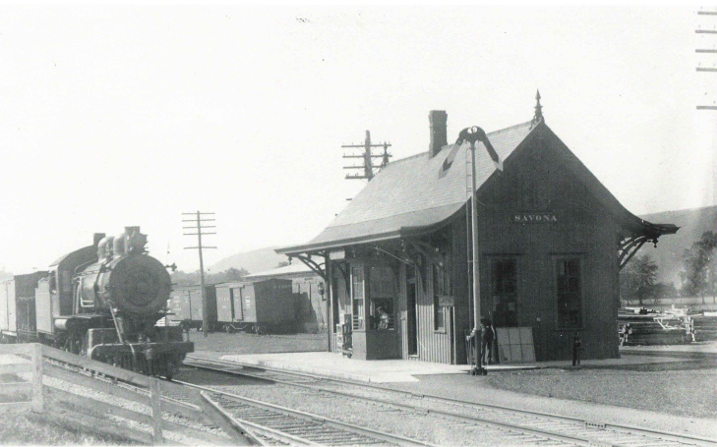Oamaru (Listeni/ɒməˈruː/; (Māori: Te Oha-a-Maru[3]), the largest town in North Otago, in the South Island of New Zealand, is the main town in the Waitaki District. It is 80 kilometres south of Timaru and 120 kilometres north of Dunedin, on the Pacific coast, and State Highway 1 and the railway Main South Line connect it to both. With a population of 13,850, Oamaru is the 28th largest urban area in New Zealand, and the third largest in Otago behind Dunedin and Queenstown.
Small City
From Bædeker's Rhine - 1873 Route 45 page 238
Oppenau is situated in the Rench valley in the Black Forest. The nearest major cities are Offenburg and Freudenstadt.
Wikipedia
At the Kreuz Inn, near Oppenau, the road to Freudenstadt and Antogast (see below) diverges to the r. At (6 M.) the busy little town of Oppenau (*Stahlbad; Post) “Kirschwasser' is largely manufactured.
Bædeker - Rhine, 1873 page 255
See Bædeker Rhine 1886 page 361
Ottenhöfen - Ottenhöfen im Schwarzwald
Ottenhöfen im Schwarzwald is a town in the district of Ortenau in Baden-Württemberg in Germany.
This is possibly the town referred to in Twain's journal:
Pretty girl here. An infernal cuckoo clock in hotel where we took dinner Offenbosen 1 1/2 hour before Allerheiligen.
Twain did not like the way of expressing distances by the time taken to get there:
This cursed way of stating all distances by minutes & hours -- it means nothing. You don't know whether it is 15 M by telegraph, or lounging, or with a sheriff after you.
Painted Post is a village in Steuben County, New York, United States. The village is in the town of Erwin, west of the city of Corning. The population was 1,842 at the 2000 census. The name comes from a painted and carved post found by explorers at the junction of three local rivers

December 2 & 3, 1895
Palmerston North (/ˌpɑːmərstənˈnɔːrθ/ pah-mər-stən-north) (Māori: Te Papaioea or transliterated Māori: Pamutana), commonly referred to by locals as Palmerston, or colloquially Palmy, is the main city of the Manawatu-Wanganui region of the North Island of New Zealand.
Palmerston North is located inland, in the eastern Manawatu Plains, near the north bank of the Manawatu River. The city is 35 km (22 mi) from the river's mouth and 12 km (7 mi) from the end of the Manawatu Gorge. It is about 140 km (87 mi) north of the capital, Wellington.
Beyoğlu (Turkish pronunciation: [ˈbejoːɫu]) is a district located on the European side of İstanbul, Turkey, separated from the old city (historic peninsula of Constantinople) by the Golden Horn. It was known as Pera (Πέρα, meaning "Across" in Greek) during the Middle Ages, and this name remained in common use until the early 20th century and the establishment of the Turkish Republic.
https://en.wikipedia.org/wiki/Beyo%C4%9Flu
The Little Traverse Bay area was long inhabited by indigenous peoples, including the Odawa people. The name "Petoskey" is said to mean "where the light shines through the clouds" in the language of the Odawa. After the 1836 Treaty of Washington, Odawa Chief Ignatius Petosega (1787–1885) took the opportunity to purchase lands near the Bear River. Petosega's father was Antoine Carre, a French Canadian fur trader and his mother was Odawa. By the 1850s, several religious groups had established missions near the Little Traverse Bay.
Sam and companions travel through Pistoia at night, by train, en route to Florence from Venice. Mark Twain Project: Quaker City Itinerary
Prahran (/pɛ'ræn/, also known colloquially as "Pran") is a suburb of Melbourne, Victoria, Australia, 5 km south-east of Melbourne's Central Business District.
In 1837 George Langhorne named the area Pur-ra-ran, a compound of two Aboriginal words, meaning "land partially surrounded by water". When he informed the Surveyor-General Robert Hoddle of the name, it was written as "Prahran".
https://en.wikipedia.org/wiki/Prahran,_Victoria
Sam and companions arrived in Ramla the evening of September 29, 1867 from Jerusalem. They departed again the morning of September 30th for Jaffa.
Mark Twain Project: Quaker City Itinerary
See Bædeker (1876) Route 2 page 133 (Ramleh)
See Bædeker (1898) Route 22 page 248 (Rámallâh)
Murray Route 16 page 276 (Ramleh)
March 20 Friday – Sam and Carlyle G. Smythe traveled 174 miles to Rawalpindi. Livy and Clara likely stayed behind, as the men returned to Lahore the next day.
Parsons calls Rawalpindi the “most heavily garrisoned of British Indian military stations” [“MT India” 92].
Sam’s notebook:
Lectured at Rawal Pindi. Dead Man, Plug, Poem, German, Golden Arm, Whistling — 1.15 [hrs] Supper-guest of Club. Left for Lahore at 12.45 [NB 36 TS 57]. Note: 12:45 p.m. on Mar. 21
Parsons writes,
Safed (Hebrew: צְפַת, Tzfat; Arabic: صفد, Ṣafad, Ashkenazi: Tzfas; Biblical: Ṣ'fath, ISO 259-3: ) is a city in the Northern District of Israel. Located at an elevation of 900 metres (2,953 ft), Safed is the highest city in the Galilee and in Israel. Due to its high elevation, Safed experiences warm summers and cold, often snowy, winters. Since the 16th century, Safed has been considered one of Judaism's Four Holy Cities, along with Jerusalem, Hebron and Tiberias; since that time, the city has remained a center of Kabbalah, also known as Jewish mysticism.
Savona. The Delaware, Lackawanna and Western Railroad (DL&W) was completed through Savona in 1882, providing direct competition with the Erie Railroad, which opened in Savona in 1852. The opening of a second major railroad convinced a majority of the residents that the town would continue to grow and need its own government. May of 1883 Savona became a village corporation.

Scone, New South Wales, Australia
Scone /ˈskoʊn/ is a town in the Upper Hunter Shire in the Hunter Region of New South Wales, Australia. It is on the New England Highway north of Muswellbrook about 270 kilometres north of Sydney, and is part of the New England (federal) and New England (state) electorates. Scone is in a farming area and is also noted for breeding Thoroughbred racehorses. It is known as the 'Horse capital of Australia'.
On September 3, 1867, a party from the Quaker City, likely including Sam, visited Scutari during the day. Mark Twain Project: Quaker City Itinerary
Springfield was originally named "Calhoun", after Senator John C. Calhoun of South Carolina. The land that Springfield now occupies was settled first by trappers and fur traders who came to the Sangamon River in 1818. The first cabin was built in 1820, by John Kelly. It was located at what is now the northwest corner of Second Street and Jefferson Street. In 1821, Calhoun was designated as the county seat of Sangamon County due to fertile soil and trading opportunities.